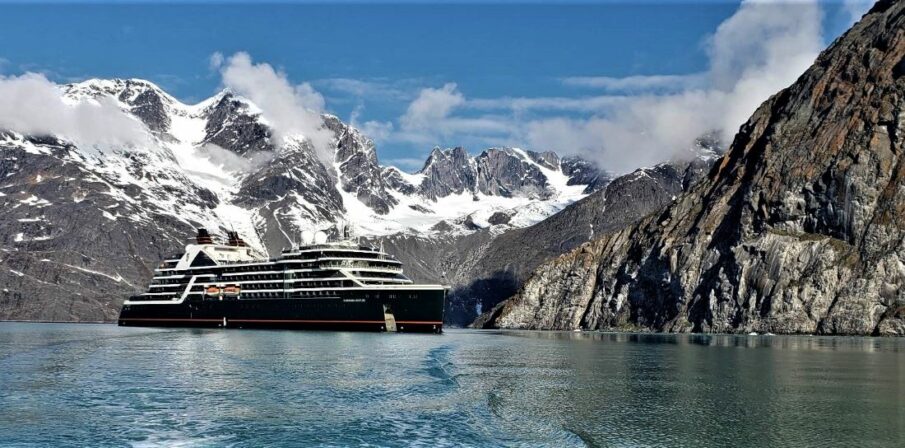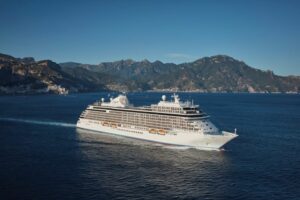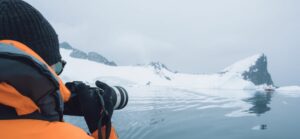When boldly going where not that many people have gone before — to the end of the Earth on a luxurious expedition cruise — where should you vacation? What’s the best choice? The Arctic or Antarctic region?
Most expedition cruise lines sail to both, of course. That said, your choice shouldn’t be a “flip a coin” decision. Yes, each polar region has some similarities, but there are also big differences. So, Arctic or Antarctic region?
Within the past seven months, The Meandering Traveler has ventured to both. In December 2022, we journeyed to Antarctica on Silversea Cruises’ expeditionary Silver Endeavour.
This week, we’re sailing around Greenland in the Arctic region on Seabourn’s expedition ship, Seabourn Venture. (See the photo above of Seabourn Venture in Eternity Fjord, Greenland; photo by Susan J. Young.)
Factors to Consider: Arctic or Antarctic?
So, here are a few of our first-hand, anecdotal tips and factoids — including what’s similar and what’s different — about both regions. Thanks to several expedition cruise lines who sail to polar regions for their suggestions too.
1. Geography
Did you know that the term “Arctic” is derived from the Greek arktos or “bear”? That’s because the constellation Ursa Major, “the greater she-bear” (also known as the Big Dipper), is always present in the northern polar sky.
So, not surprisingly, the term “Antarctic” translates into “opposite the bear.”
What’s similar? Certainly, the Arctic and Antarctic regions are both at “the ends of the Earth.” Yet, they’re nearly 12,500 miles apart lying at opposite extremes.
They encompass either the North Pole or South Pole, although most expedition cruises don’t go to either. Ponant’s icebreaker, Le Commadant Charcot, has sailed to the geographic North Pole previously, and another expedition through A&K Group is planned this year as a charter.
But 99 percent of other expedition ships have not. In addition, the South Pole is in the midst of the land mass of Antarctica, so getting right to the pole isn’t an option on a cruise.
Latitudinal Circles
Geographically, though, cruisers have plenty to see within both polar regions. The Arctic is a polar territory above 66.5 degrees north, while Antarctica is a polar territory below 66.3 degrees south.
The Arctic Circle, the northernmost circle of latitude, extends through or within territories/islands belonging to Canada, Alaska, Russia, Norway, Finland, Sweden, Greenland and Iceland.
In contrast, the Antarctic Circle passes through the area just north of the Antarctic continent, which is some 600 miles south of South America.
2. Water or Land
The big difference between the Arctic or Antarctic is geological.
Arctic = Water
Heading to the Arctic region, you’re journeying to an ocean area that’s covered by perennial sea ice. Not all sea ice melts up north during the summer months. So, at some locales, new ice simply piles onto the old.
While the region is a vast ocean, it does either encircle or touch several major islands — Svalbard in Norway, or Greenland, the world’s largest island, for instance.
It also touches such land areas as northern, peninsular Norway, northern Canada, the U.S. and Russia.
Antarctica = Land
Covering 5.5-million square miles, Antarctica — in contrast — is one of the world’s seven continents. Known as “The White Continent,” this land mass is 98 percent covered in ice on a year-round basis.
Think about valleys, mountains, some lakes/rivers and active volcanos. Actually, beneath the thick ice, the continent has those features. The ice thickness, though, is some 13,000-plus feet at points.
In fact, Antarctica’s extremely thick ice sheet is Earth’s largest; it also contains 99 percent of the world’s fresh water.
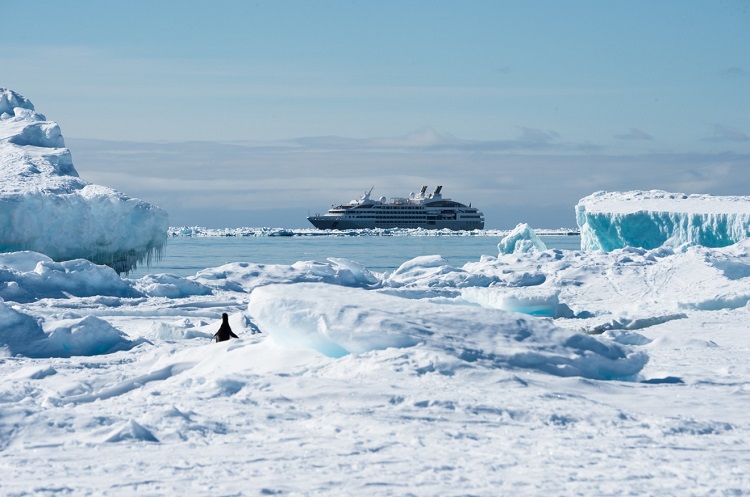
Looking out from expedition ships at sea, modern day explorers see icy Antarctica mountains towering over a serene landscape. They also peruse huge glaciers flowing to the sea.
Some of Antarctica’s peaks soar to 16,000 feet. The continent is ringed by sea ice and the Southern Ocean. It’s the world’s highest, driest, coldest and windiest continent.
3. Who’s Governing?
In the Arctic, which has vaguely defined limits, any land, territorial seas and EEZs are under the jurisdiction of one of eight Arctic coastal nations. That includes Canada, Denmark (per Greenland), Finland, Iceland, Norway, Russia, Sweden and the United States. International law also is in force.
Antarctica does not belong to any one country, nor does it have permanent inhabitants with homes. It’s governed by multiple nations under an international treaty signed in 1959. That treaty started being enforced in 1961.
Only small scientific bases of individual countries are on land in Antarctica; plus, they only operate at certain times of the year.
4. Climate and Temperatures
Though both polar regions are cold and dry, each has its own unique terrain and climate. In essence, wintertime in the Arctic south of the North Pole is on the same seasonal track as North America, although temperatures remain a bit cooler.
Thus, Arctic expedition cruises operate from May through September. The most popular Arctic cruise months tend to be June through August.
However, Antarctica is in the Southern Hemisphere. So, when it’s winter in North America, it’s the opposite season — summer — in Antarctica.
Thus, expedition cruise lines typically visit Antarctica between October/November and March/April, depending on expedition line. While temperatures remain cool, they’re not unbearably frigid.

For both regions during the summer season, you’ll still typically need a winter parka. Temperatures are often in the 20s to 40s on expedition outings.
Some areas of the Arctic such as peninsular Norway can be a bit warmer, perhaps in the 50s or so.
Parkas and Equipment
Typically, the lines provide parkas for their Arctic or Antarctic guests, such as both Seabourn and Silversea (see adjacent photo) did on our recent trips.
Some lines provide waterproof pants too (as Zodiacs can stir up spray that enters the boat). Most lines provide waterproof boots for guests to use during the voyage.
Each expedition line is a bit different. Some provide hats, others do not. Some provide a waterproof case for a standard-sized phone, others not. So, be sure to ask about gear before departure, but most lines send guests a list of items and explain what’s included.
Thank Goodness, It’s Not Winter
Expedition cruise lines don’t visit either the Arctic or Antarctic region in their normal winter season. Just to give you a hint of winter temperatures, the Arctic has an average winter temperature of minus 40 degrees Fahrenheit.
But that’s almost balmy by Antarctic standards. The world’s coldest temperature in Antarctica’s winter was -129 (yes, below zero); that was recorded at the Russian research center in Vostok in 1983.
Arctic and Antarctic: Midnight Sun
Given the Earth’s axial tilt (one region tilts away from the sun or closer to it at different seasons), the Arctic and Antarctica both have unique sunlight/or lack of.
In the summertime for each region, it’s time for “the midnight sun” where sunlight lasts 24 hours a day. Each region, in turn, also experiences the “polar night.” That’s during each region’s winter season when the sun never shines. Darkness is present the entire day.
Cruise ships typically only visit in each region’s “summer.” So, no matter which type of expedition cruise you’re taking — Arctic or Antarctica — you’ll find black-out drapes in your cruise stateroom or suite. That allows guests to sleep comfortably without sunshine.
On Seabourn Venture, for example, our stateroom team is pulling our drapes nightly during their evening turn-down service.
When we returned to the suite after the night-time entertainment one night (after 11:30 p.m.), we peeked outside. Yep, we were greeted with bright light, despite the late hour.
Speaking of Temperatures
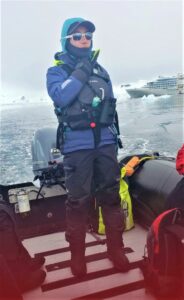
Yes, both regions can be absolutely frigid in their wintertime periods. But expedition cruisers are visiting in each region’s summer season.
During our time in the Arctic this June, it was cool in the 40s much of the time in Greenland, but in the 30s north of the Arctic Circle. In Antarctica in late December when we visited, it was even cooler at times.
In both spots, we definitely needed our parka (provided free of charge by both the cruise lines), but never felt it was uncomfortably cold when we were bundled up — even on a Zodiac ride (see photo of Silversea Zodiac guide at right).
5. Arctic or Antarctic: Flora Differences
Since Antarctica is a land of ice, it’s harsh and inhospitable to flora. In fact, you’ll only find two native vascular species of plants in Antarctica. They’re the spiky Antarctic hair grass and Antarctic pearlwort.
They’re both pollinated by the wind. You’ll possibly also spot non-native blue grass.
Antarctica has some rare lakes and a few rivers, but none flowing year-round. There’s little land vegetation. Don’t expect to see shrubs or trees, but there are small areas of tundra, more so on the subantarctic and Antarctic islands.
Flora in the Arctic
Flora lovers often choose to instead cruise within the Arctic region, which has a huge amount of tundra.
In addition, in peninsular Norway, for example, bit warmer land temperatures (thanks to the warm Gulfstream ocean current) results in the presence of more flora and even forests.
The Arctic is home to approximately 900 flowering plants. One lovely Arctic flower is the Svalbard poppy, which is either yellow or white. It’s the symbol of this Norwegian island.
Another Arctic flora of note is the Arctic parraya, a pinkish-purple flower blooming between June and July.
One issue for polar plants? The Arctic typically gets an average of less than 20 inches of precipitation annually. The Antarctic, despite the icy look, is functionally a desert. For instance, the area around the South Pole averages six inches of precipitation each year.
6. Arctic or Antarctic? Fauna Differences
The Arctic supports a wide range of fauna. One reason? In winter, the sea freezes over, creating a connection with mainlands in continental Europe, North America and Asia.
That’s had the impact of increasing the number of species people can see today in the region. Here’s a partial list of critters that travelers may have the possibility of spotting in the Arctic:
- Polar bears
- Whales (17 different species)
- Narwhals (called “the unicorn of the sea”)
- Arctic fox
- Arctic hare
- Musk ox
- Caribou/Reindeer
- Dozens of species of birds including the Snowy Owl, Peregrine Falcon and Snowy Goose
- Wolves and wolverines, depending on locale.
- Squirrels
- Insects including mosquitos (bring insect repellent).
After our charter Seabourn flight from Reykjavik, Iceland, landed at Kangerlussuaq, Greenland, we boarded a shuttle to the small port pier. From there we headed by tender or Zodiac to embark the ship.
But en route, alas, we were thrilled to spot two reindeer and farther out, one musk ox.
We’re still sailing this week on Seabourn Venture and heading in a few days for the “pack ice” floating along eastern Greenland. We hope to spot a polar bear or two. But there are no guarantees, of course.
You may wonder how polar bears survive in such a harsh climate. They have two layers of fur and a thick layer of fat, so they’re able to withstand those bone-chilling Arctic winters.
If it’s too cold, they’ll dig a cozy snow den and cover their nose to prevent a loss of heat. Of course, their fur is also oily and thus water-repellent. They’re terrific swimmers.
What you won’t see in the Arctic? There are no penguins in that region.
Antarctica Fauna
In Antarctica, travelers will have the potential to spot fauna too, mainly:
- Penguins — Adelie, Chinstrap, Gentoo, Macaroni, Emperor and other species.
- Sea lions
- Seals including Fur, Sea, Leopard, Elephant, Crabeater, Weddell and other species.
- Whales
- 40 species of birds.
There are no land mammals in Antarctica. There are no insects either, with the exception of one wingless insect, the Belgica Antarctica (Antarctic midge), that does live there.
But no, you’ll have no chance of spotting polar bears in Antarctica. But you likely will spot penguins and lots of them.
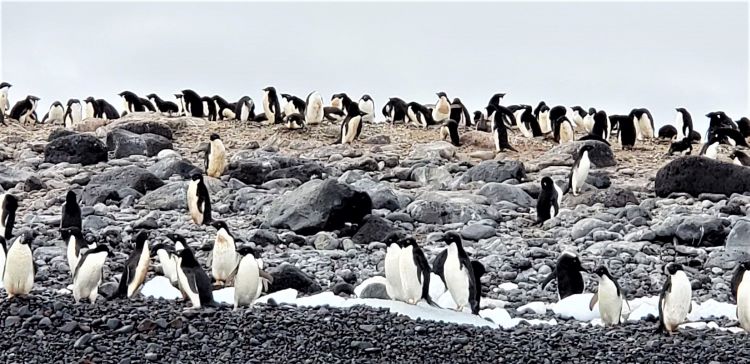
That’s because penguins can survive in the harshest of conditions. On Paulet Island, for example, we gazed out to view more than 100,000 pairs of breeding penguins — as far as our eyes could see. Here’s a look at a previous Meandering Traveler blog about the penguins and our Antarctica cruise.
7. Civilization or Not?
For up to 45 million years, Antarctica has been separated from civilization and other continents by the vast Southern Ocean. It’s extremely remote, of course, but it also has inhospitable weather conditions.
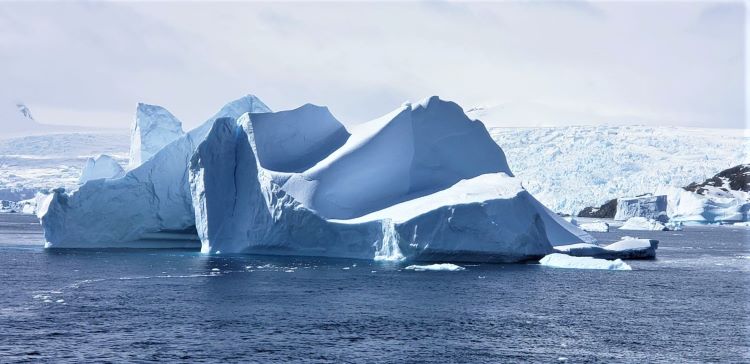
Most notably, though, it has no natural land bridges that connect it to other continents. Did you know that Antarctica was only discovered in 1820?
Even today, there’s essentially no civilization in Antarctica — no permanent inhabitants. All you will find, and rarely see, are scientific teams that rotate in and out.
Research Structures, No Homes
So, you may see a few buildings, for example, as we did flying into King George Island, a subantarctic island from which we boarded Silver Endeavour.
On more than a week of our Antarctica cruise we saw virtually no signs of modern civilization. We only passed one Hurtigruten ship at one point.
Otherwise, it was sheer silence and communing entirely with Mother Nature.
That said, the Arctic in contrast has been inhabited for millions of years. So, for those in search of culture and heritage of the local people, an Arctic expedition cruise has great value.
Cultural Enrichment in the Arctic
If you are interested, however, in a cultural experience while on an expedition voyage, then the Arctic is likely the place for you. The Arctic’s population is estimated at 4 million people.
That includes more than 40 indigenous communities with highly diverse heritage and cultures. Travelers will encounter the Inuit who live in Alaska, northern Canada, and Greenland.
In addition, the Saami live in the circumpolar areas of Finland, Norway, Sweden and northwestern Russia. The Chukchi live in Siberia and the Russian Far East.

During our current Seabourn Venture cruise, while the ship was visiting a port in western Greenland, two guides of Inuit heritage boarded the ship. They offered a cultural presentation of Inuit chants, singing, dancing and tales. Again, this simply isn’t an experience you’d have in Antarctica.
And in Sisimiut, Greenland, just north of the Arctic Circle, cruisers got off dockside at a small town. They could see huge cargo containers and equipment on the dock, but only a few vehicles (trucks and cars) buzzing around and a small scattering of homes atop the adjacent hills.
Seabourn’s guests walked up a hill to enjoy a town tour, a church visit and dog pack compound tour. Most interestingly, they were treated to a local tasting of traditional dishes. How about some whale blubber, small shrimp or musk ox broth?
Arctic or Antarctic: Different Worlds
So, Antarctica equals Mother Nature’s world in its purest form without remnants of civilization, while the Arctic is a combination of the natural world AND the human factor.
People have lived in the Arctic region, despite its winter harshness, for tens of thousands of years.
In 2012, an 11-year-old boy exploring the foggy coast of Yenisei Bay, about 1,500 miles south of the North Pole, discovered remains of a woolly mammoth. Scientists determined that it had been killed by humans. When the remains were dated, the big surprise was that the mammoth died 45,000 years ago.
8. Arctic or Antarctic: Icebergs
The icebergs found in the Arctic come from parts of the ice sheet flowing to the sea. Cruisers will find them mostly irregular, jagged and usually modest in size.
However, the largest icebergs on Earth are in Antarctica. As mountains of frozen freshwater, they can be majestic to view. Did you know that in 2017 an iceberg measuring 24,000 square feet in size broke free from a western Antarctica ice shelf?
9. Arctic or Antarctic: Special Occasions
“Special occasions — a milestone birthday, anniversary or other celebration — are the perfect reason to splurge on an Arctic or Antarctica cruise,” says Shelby Steudle, president, Pavlus Travel. “Either region can make the perfect location for that ‘bucket list’ adventure that involves celebrating a special occasion.”
For an opportunity to possibly spot the Arctic northern lights, travelers might consider an East Greenland cruise in September.
Or, for an amazing Christmas and New Year’s cruise, head for Antarctica. We did so on Silver Endeavour last December and loved all the shipboard holiday traditions — caroling on the ship, Christmas Eve gatherings, holiday dinners and so on.
But we also loved gazing at the pure beauty of the Antarctic landscape — ice and snow — during the holiday season. We sat in Silver Endeavour’s two-deck, glass-enclosed Pool Grill on Christmas Day and watched snowflakes wafting downward outside. It was magical.
But we also had fun inside the ship (as witnessed at the holiday party put on the Explorer Lounge for guests in the photo below).

And, in both polar regions, we watched our fellow travelers of all ages “take the polar plunge” — jumping into frigid waters to celebrate the journey.
10. Arctic or Antarctic Cruise?
Now, let’s talk “getting there.” It’s not a journey cross-country or even to Europe. It’s much farther. But it’s definitely worth the trip.
Still, it’s good to remember that those opting for an Arctic region cruise or an Antarctica voyage are traveling to the ends of the Earth. So, be prepared and “go with the flow.”
It’s common for the trip from your home city to either region to take two, 2.5 or three days. That can include a hotel stay of one or two nights, often in different cities.
Drake Shake or Drake Lake
Guests heading to an Antarctica cruise can choose a fly option, which will take guests to King George Island in the South Shetland Islands. Or, they can instead opt to transit of “The Drake Passage,” a waterway that can be infamously rough at times.
It’s also calm at some other times, so travelers could either experience the so-called “Drake Shake” or “Drake Lake,” or a combination.
Here’s a helpful Drake Passage fact sheet prepared by Hurtigruten, an expedition cruise operator. Some travelers desire to avoid the Drake Passage and instead take — as we did with Silversea — the air link. Silversea, though, offers both options.
Other travelers choose the full sea journey for “bragging rights” — to show they’ve ventured through that notorious Drake Passage. It’s a personal choice.
If choosing the seagoing passage, typically guests will then board their ship a bit earlier — in either Punta Arenas, Chile, or Ushuaia, Argentina. They’ll still have more time involved sailing southward, but they’ll be settled in their stateroom or suite a bit earlier.
Heading to the Arctic often involves flying to Greenland, Iceland or Norway. Each itinerary is different. Talk with a Pavlus Travel personal travel planner about all the options.
It Takes Time, It’s Worth It!
So, yes, heading to the ends of the Earth takes time. But we’d have to say this: “It’s definitely worth it!” It’s a bucket list option unlike any other.
Guests that we spoke to on our Seabourn Venture Arctic journey this past week were loving the adventure. Your personal travel planner can best explain the steps in the journey, based on the type of trip you’re considering.
11. Arctic or Antarctic Region: Flexibility
As explained, the journey to either the Arctic or Antarctica is typically a multi-day affair. So, flexibility is imperative. Just pack your patience for the journey as well as your bag.
Once on the ship, you’ll also need flexibility. Both Arctic and Antarctic travel is weather sensitive. In such harsh climates with sea conditions in a polar zone, it’s imperative for the crew to check, check and recheck to assure the route is doable and safe.
In Antarctica, the expedition team may stay up the night looking at what landing sites in remote bays and coves have been “reserved.” There’s a process governed by the International Association of Antarctic Tour Operators (IAATO) for reserving a spot for the ship to explore each day. The goal is to do no harm to the environment.
On many occasions, our expedition leader for Silversea was able to secure what she felt was a better slot by staying up late into the night. She’d grab an even more advantageous landing spot, after another line may have opted — distance-wise, weather-wise or whatever — to give up their spot.
Changing Conditions and Experiences
So, there is no hard and firm landing site on any one day — it can change from what was planned earlier based on many factors including weather.
In the Arctic, sea ice was an issue this past week along Greenland’s coast. So, instead of heading south one day, we went north. In fact, during the call at Sisimiut, guests onboard Seabourn Venture were told that it was the first cruise industry ship of its size in this western Greenland spot.
Since the waters were uncharted, bridge officers and other crew members led the way on a Zodiac. That craft had underwater sonar (called WASP) to lead Seabourn Venture through those uncharted waters.
The goal was a safe passage. And it was. Reaching Sisimiut, it was rewarding. Yet, it wasn’t where we were supposed to go.
So, flexibility is paramount for any cruise guests heading to both polar zones.
12. Parting Thoughts
If you’re a history buff who desires to see the iconic spots of Sir Ernest Shackleton’s adventures in the Southern Ocean, that’s possible. You can possibly venture to Elephant Island, where the explorer’s crew spent a harsh winter until they were rescued.
If the expedition goes to South Georgia, you can even visit Shackleton’s grave.
Alternatively, if you’re more interested in such polar explorers as Cook, Nansen and Peary, for instance, then you might choose a journey north to the Arctic region. You can visit sites they explored and imagine their hardship journey.
For both types of expedition cruises, you can bask in the warmth and pampering service onboard a luxury expedition ship.
Drum roll, please!!!
Now that we’ve whet your appetite to learn more, stay tuned for our blog next week. Yep, we’ll focus on five super-duper options for Arctic or Antarctic adventures.
So, check back next week for “Five Best Arctic or Antarctic Expedition Cruises.” Or, if you simply can’t wait, no problem.
Simply contact Pavlus Travel today. An expert personal travel planner will start you on your polar journey by discussing the best Arctic or Antarctic options for you, based on your travel style, budget and personal interests.
